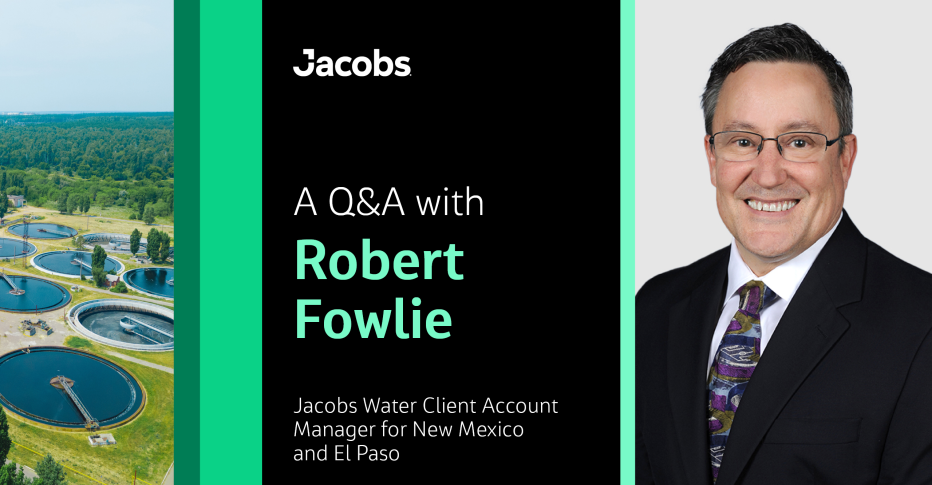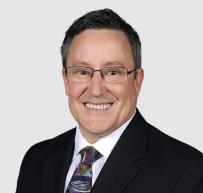
Water is one natural resource we all share – it shapes our lives, our communities, our ecosystems and the Earth’s climate. But managing this essential resource has never been more complicated.
From climate change to emerging contaminants, our clients are facing unprecedented challenges as they work to provide critical water services and protect their communities and the environment.
At Jacobs, our planners, engineers and scientists work with our clients every day to solve their water challenges through a OneWater lens – viewing all water as resource and developing integrated, holistic solutions that provide comprehensive benefits.
In this Q&A, we connect with Robert Fowlie, a new member of our team who’s working with our clients in New Mexico and El Paso to protect and enhance the state’s water supply. Robert weighs in on the trends shaping the water industry today and how our clients are using a OneWater approach to prepare for the future.
Tell us a bit about your role as a client account manager.
I joined Jacobs just over a year ago to manage our water client relationships in New Mexico and El Paso. While my job is regarded as a sales role, I consider my primary focus to be creating and maintaining relationships. I’m a native of New Mexico and have worked in this state and in El Paso for almost 18 years on many signature water projects with Albuquerque Bernalillo County Water Utility Authority, Camino Real Regional Utility Authority, the City of Farmington and El Paso Water. Coming to Jacobs, I provide my clients the same trusted advisory and experience they’ve come appreciate, while also adding an extensive global bench of resources to support their projects and initiatives.
What are the key water challenges we’re solving for our clients in New Mexico?
Our largest, most significant project is the Eastern New Mexico Rural Water Project, which will convey and treat surface water from Ute Lake to customers in Clovis, Portales, Cannon Air Force Base, Elida and Texico. Currently, these communities rely on groundwater from the Ogallala Aquifer in eastern New Mexico, which is drying up. The Eastern New Mexico Rural Water Project will provide a more reliable water supply for these communities into the future.
We’re also working with the Albuquerque Bernalillo County Water Utility Authority on numerous complex projects including reuse water pipelines and pumping stations to supply reuse water – or recycled, reclaimed water – for irrigation; integrated water resource master planning and preliminary design of an advanced water treatment plant that would treat a combination of industrial waste and reuse water for use in solar panel manufacturing.
What are some of the biggest opportunities ahead for water supply?
Solutions that take a OneWater approach like water reuse are important and should be considered where there are demonstrated water scarcity issues like the ones experienced in Arizona, Nevada and California. In New Mexico, water reuse is primarily used to reduce the demand for potable water used for irrigation (purple pipe systems). Albuquerque and Rio Rancho have implemented systems for indirect potable reuse, which have been very successful in sustaining and raised groundwater levels in the aquifers they rely on for supply.
Is there a project you’re particularly proud of?
In 2022 and 2023, I worked on the Village of Cloudcroft’s direct potable reuse (DPR) project, which was initially planned to be New Mexico’s first DPR project. The project had not been completed and I helped the village to develop a framework for deciding how to finish the project or integrate the infrastructure that had been constructed into their water system that serves a population of approximately 800 people. DPR projects are complex and costly, and as a result most communities in New Mexico do not have the resources to construct and operate advanced water treatment facilities. This project was significant because it helped the village make informed decisions about the future of their water supply and provided the village and the State of New Mexico with a case study on how challenging DPR projects can be. There needs to be a trigger and clearly defined reason to pursue a DPR project in a rural community and the challenges of building and operating complex treatment facilities need to be considered before moving forward.
Since there’s no new water on earth, we’re drinking the same water today that dinosaurs did. While the water itself isn’t new, the technologies to use and treat it are continuously evolving. Where do you see the industry heading?
In the next five years, I see the water industry implementing artificial intelligence (AI) systems as tools for increasing the efficiency of water and wastewater operations and to help utilities develop solutions for handling the impacts of climate change. At Jacobs for example, we have a suite of digital OneWater tools supporting our clients with integrated data solutions across the water cycle.
I also see the industry continuing to look at OneWater solutions, especially in the western U.S. I’m hopeful there will be continued investment in replacing existing infrastructure as most communities are struggling to replace water and wastewater infrastructure that has reached the end of its useful life and need a more resilient supply for tomorrow.
What drew you to join #OurJacobs team?
I had the opportunity to work with the local Jacobs team in Albuquerque on a pursuit in 2022. I was impressed with the staff, and we connected on many levels. We worked with the same clients and our approach to business, client management and project delivery were similar. I was offered an opportunity to join Jacobs as the client account manager in New Mexico and I was excited for the opportunity to work with experienced project managers and staff and a company with a great reputation, experience and resources. I’ve been very impressed with Jacobs as a company and am glad to be here. It’s a good fit for me.
About the interviewee

Robert Fowlie joined Jacobs as a client account manager for New Mexico and El Paso in 2023. Robert graduated from New Mexico State University in 1986 and has enjoyed a varied and challenging engineering career. He started his career with the Los Angeles Department of Water and Power in 1987 and has worked on water projects all over the U.S., including Chicago, Seattle and Savannah, Georgia. He returned to New Mexico in 2006 and has worked on water projects in New Mexico, El Paso and West Texas. He is a registered professional engineer in New Mexico, Texas, and California and is also a Board Certified Environmental Engineer in water supply and wastewater. Outside of work, Robert enjoys road biking, all sports and spending time with family.














































